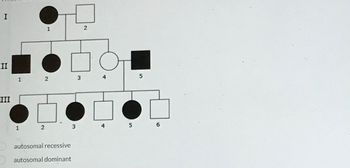
Human Anatomy & Physiology (11th Edition)
11th Edition
ISBN: 9780134580999
Author: Elaine N. Marieb, Katja N. Hoehn
Publisher: PEARSON
expand_more
expand_more
format_list_bulleted
Concept explainers
Topic Video
Question
Which option best describes the pedigree

Transcribed Image Text:# Pedigree Analysis: Identifying Inheritance Patterns
## Overview
Pedigree analysis is a fundamental tool in genetics to study the inheritance of traits in families. This tool allows us to track the occurrence and predict the probability of traits and genetic disorders passing from one generation to the next.
## Explanation of Diagram
The given diagram represents a pedigree chart, which is used to analyze a trait (or disorder) within a family. This particular pedigree involves three generations and includes both males (squares) and females (circles).
### Generation I
- **Individual 1**: Female (affected, represented by filled circle)
- **Individual 2**: Male (unaffected, represented by an unfilled square)
### Generation II
- **Individuals 1 and 2**: Both are affected females (filled circles)
- **Individuals 3 and 4**: Both are unaffected males (unfilled squares)
- **Individual 5**: Affected male (filled square)
### Generation III
- **Individual 1**: Affected female (filled circle)
- **Individual 2**: Unaffected male (unfilled square)
- **Individuals 3 and 4**: Both are unaffected males (unfilled squares)
- **Individual 5**: Affected male (filled square)
- **Individual 6**: Unaffected male (unfilled square)
## Interpreting the Inheritance Pattern
The chart provides a clear visual of the inheritance pattern. The individuals who are affected by the trait in question are shaded, whereas those unaffected are left unshaded. By analyzing the pattern across generations, one can determine whether the trait follows an autosomal dominant or autosomal recessive inheritance pattern.
**Options for the mode of inheritance**:
1. **Autosomal Recessive**
2. **Autosomal Dominant**
### Potential Analysis:
- **Autosomal Dominant Inheritance**: If a trait is autosomal dominant, at least one parent must be affected to pass the trait to the offspring. Observing the chart, we notice that affected individuals appear in every generation which hints towards a dominant pattern.
### Conclusion:
Based on the given pedigree chart, the trait appears to follow an autosomal dominant pattern. This is inferred from the pattern of inheritance wherein the trait is seen in multiple members across three generations and does not skip a generation.
Make sure to consult with a genetic counselor or medical professional for accurate diagnosis and analysis.
Expert Solution
This question has been solved!
Explore an expertly crafted, step-by-step solution for a thorough understanding of key concepts.
Step by stepSolved in 3 steps

Knowledge Booster
Learn more about
Need a deep-dive on the concept behind this application? Look no further. Learn more about this topic, biology and related others by exploring similar questions and additional content below.Similar questions
- FIGURE 4: A five generation pedigree. Shaded boxes and squares represent individuals with the phenotype being examined. 3) What is the mode of inheritance for the trait in Figure 4?arrow_forwardplease answer parts a and barrow_forwardThe pedigree below represents an autosomal recessive disease. What characteristic(s) of the pedigree supports this statement? Write the genotypes and their genotype probabilities in fractions and percentagesarrow_forward
- The question and picture its reffering to is in the image.arrow_forwardThis is a schematic representation for a bi-allelic gene with a recessive allele a that causes a specific disease. Use your cursor to select the part of this diagram that represents the homozygous recessive event. Saa AA Aaarrow_forwardNumber of offspring resulting from a Punnett square that are homozygous recessive when two heterozygous parents are crossedarrow_forward
- If the Lillian was a surrogate for an unrelated egg and sperm donor, how much DNA would you expect the child and Lillian to share? 0% 25% 50% 75%arrow_forwardPossible Options: A. 1/3 B. 2/3 C. 1/2 D. 1/4arrow_forwardA cross between a yellow rat with a yellow rat always produce yellow offspring. crosses between a white rat with a white rat always produce white offspring. the alleles affect the same aspect of coat color. the cross of a white rat with a yellow rat produces a cream rat. this type of inheritance pattern is called _______________?arrow_forward
arrow_back_ios
SEE MORE QUESTIONS
arrow_forward_ios
Recommended textbooks for you
 Human Anatomy & Physiology (11th Edition)BiologyISBN:9780134580999Author:Elaine N. Marieb, Katja N. HoehnPublisher:PEARSON
Human Anatomy & Physiology (11th Edition)BiologyISBN:9780134580999Author:Elaine N. Marieb, Katja N. HoehnPublisher:PEARSON Biology 2eBiologyISBN:9781947172517Author:Matthew Douglas, Jung Choi, Mary Ann ClarkPublisher:OpenStax
Biology 2eBiologyISBN:9781947172517Author:Matthew Douglas, Jung Choi, Mary Ann ClarkPublisher:OpenStax Anatomy & PhysiologyBiologyISBN:9781259398629Author:McKinley, Michael P., O'loughlin, Valerie Dean, Bidle, Theresa StouterPublisher:Mcgraw Hill Education,
Anatomy & PhysiologyBiologyISBN:9781259398629Author:McKinley, Michael P., O'loughlin, Valerie Dean, Bidle, Theresa StouterPublisher:Mcgraw Hill Education, Molecular Biology of the Cell (Sixth Edition)BiologyISBN:9780815344322Author:Bruce Alberts, Alexander D. Johnson, Julian Lewis, David Morgan, Martin Raff, Keith Roberts, Peter WalterPublisher:W. W. Norton & Company
Molecular Biology of the Cell (Sixth Edition)BiologyISBN:9780815344322Author:Bruce Alberts, Alexander D. Johnson, Julian Lewis, David Morgan, Martin Raff, Keith Roberts, Peter WalterPublisher:W. W. Norton & Company Laboratory Manual For Human Anatomy & PhysiologyBiologyISBN:9781260159363Author:Martin, Terry R., Prentice-craver, CynthiaPublisher:McGraw-Hill Publishing Co.
Laboratory Manual For Human Anatomy & PhysiologyBiologyISBN:9781260159363Author:Martin, Terry R., Prentice-craver, CynthiaPublisher:McGraw-Hill Publishing Co. Inquiry Into Life (16th Edition)BiologyISBN:9781260231700Author:Sylvia S. Mader, Michael WindelspechtPublisher:McGraw Hill Education
Inquiry Into Life (16th Edition)BiologyISBN:9781260231700Author:Sylvia S. Mader, Michael WindelspechtPublisher:McGraw Hill Education

Human Anatomy & Physiology (11th Edition)
Biology
ISBN:9780134580999
Author:Elaine N. Marieb, Katja N. Hoehn
Publisher:PEARSON

Biology 2e
Biology
ISBN:9781947172517
Author:Matthew Douglas, Jung Choi, Mary Ann Clark
Publisher:OpenStax

Anatomy & Physiology
Biology
ISBN:9781259398629
Author:McKinley, Michael P., O'loughlin, Valerie Dean, Bidle, Theresa Stouter
Publisher:Mcgraw Hill Education,

Molecular Biology of the Cell (Sixth Edition)
Biology
ISBN:9780815344322
Author:Bruce Alberts, Alexander D. Johnson, Julian Lewis, David Morgan, Martin Raff, Keith Roberts, Peter Walter
Publisher:W. W. Norton & Company

Laboratory Manual For Human Anatomy & Physiology
Biology
ISBN:9781260159363
Author:Martin, Terry R., Prentice-craver, Cynthia
Publisher:McGraw-Hill Publishing Co.

Inquiry Into Life (16th Edition)
Biology
ISBN:9781260231700
Author:Sylvia S. Mader, Michael Windelspecht
Publisher:McGraw Hill Education